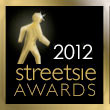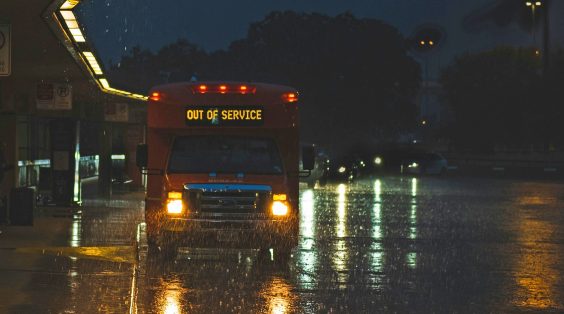Streetsblog NYC is kicking off our annual awards bonanza with a look at the projects that did the most to improve walking, biking, and transit on New York City streets in 2012. Catch up on the people's choice voting before you dive in, and stay tuned for more Streetsies before the new year.
Also, we are thisclose to reaching our year-end pledge drive goal. Please make a tax-deductible contribution to Streetsblog and Streetfilms and help us bring you coverage and commentary that makes a difference for NYC streets in 2013.
On to the Streetsies...
Best Livable Streets Story and Best Pedestrian Safety Project
When NYC DOT invited neighborhoods to apply for 20 mph slow zones, the agency triggered an overwhelming "Yes in My Backyard" response. Applications came in from all over the city. School kids in a Bronx neighborhood plagued by cut-through traffic wanted one. So did a City Council member from central Queens. So many neighborhoods wanted one, in fact, that there was no way to satisfy the demand. Not this year, at least. A lot of people were disappointed, but that's also, in a way, what made the clamor for slow zones such a great story.

Instead of the superficial, boilerplate story about street redesigns that the NYC dailies and evening newscasters excel at (It goes like this: A few people don't understand why the street is changing, and they're angry about losing a few free parking spots! The End.), all those slow zone applications got at something deeper. New Yorkers want their own neighborhood streets to be safe enough for their kids to play and for their grandparents to walk without fear. For that to happen, the streets need to change.
After logging some promising early results from the city's first 20 mph slow zone, installed in Claremont last year, DOT expanded the program this summer to 13 more neighborhoods. These are low-cost improvements -- stripes, signs, and speed humps -- and they don't yet measure up to London's 20 mph zones, which save dozens of lives each year using more intensive traffic-calming treatments. But these first-generation slow zones can get upgraded later, and with the opt-in process DOT has set up, there's every reason to expect that momentum for this type of traffic-calming will build as more neighborhoods ask for their own slow zones. The demand for safer streets isn't going anywhere.
Best New Public Space
Sometimes, the popularity of a street reclamation project seems to be directly proportional to the volume of coverage about how "controversial" it is. The Streetsblog readers' choice for best new public space of 2012 -- Fort Greene's Fowler Square Plaza -- is a case in point. (See also: Prospect Park West.)
Most Fowler Square coverage was all about the hecklers at the planning meetings and the guys who kvetched over having to drive an extra block. Once the tables and chairs were laid out, though, most people seemed to agree that it's just a great place to sit down, enjoy the neighborhood, and kibitz a bit. Good thing it's here to stay.

Best Bike Project
When it comes to giving New Yorkers safe, comfortable bike access to where the jobs are, the West Side protected bike lane extension from 34th Street to 59th Street is probably the most significant NYC DOT bicycle project Streetsblog has ever covered. It's making it a whole lot safer to walk in these parts, too. The new pedestrian islands and narrower traffic lanes will do wonders for blocks with epic amounts of foot traffic.
It looks like 2013 will be the year this project really shines, though. Once bike-share gets up and running, Eighth and Ninth Avenues will be bike highways to the West Side's commuter transit hubs. And if everyone takes Gale Brewer's advice, sometime next year there should be a nice new link to these protected bike lanes from points north.

Best Transit Project
The debut of Select Bus Service on Staten Island comes in a close second in this category. Thousands of riders each day are getting speedier bus trips on Hylan Boulevard with SBS in place. Top prize, though, goes to the rollout of Bus Time across all of Staten Island and the Bronx, bringing real-time bus location information to riders via smartphone and, lest we forget, text message. Millions of New Yorkers can take the guesswork out of waiting for the bus thanks to this one (which, full disclosure, was developed for the MTA by OpenPlans, Streetsblog's parent organization).
Feel-Good Story of the Year
It's getting to be a sub-genre unto itself on Streetsblog: the super-inspiring livable streets story out of Jackson Heights. Two years ago it was the march on Community Board 3 that won a summer-long car-free 78th Street. This year it was the merchants who, after lashing out against the new public plaza on 37th Road, turned around and embraced it, thanks to some outstanding mediation by Council Member Daniel Dromm and DOT (not to mention the merchants' own self-interest). "Diversity Plaza" is going to be drawing potential customers to the heart of Jackson Heights for a long time.

The cherry on top: By recognizing that maintaining and caring for the plaza would be more profitable than orphaning it, the merchants demolished some meticulously constructed plazas-kill-local-business Times reportage.
The Safe Routes to School Award
DOT's traffic-calming road diet for 50 blocks of Brooklyn's Fourth Avenue is making a huge difference for Sunset Park families, who no longer have to worry about getting sandwiched between six lanes of screaming traffic while trying to balance on a narrow, two-foot wide median strip.
Best Use of Paint and Planters
The 49-foot curb extension at the northwest corner of Delancey and Clinton.
Most Satisfying Sight
After at least three rounds of community board votes, thousands of letters delivered to City Hall, and more than two years of waiting since the proposal was first unveiled by the city, East Harlem got its first protected bike lane segment on Second Avenue this fall. It wouldn't have happened without leadership from Council Member Melissa Mark-Viverito and a posse of hardworking volunteers. Here's the Streetfilm that tells the story:






